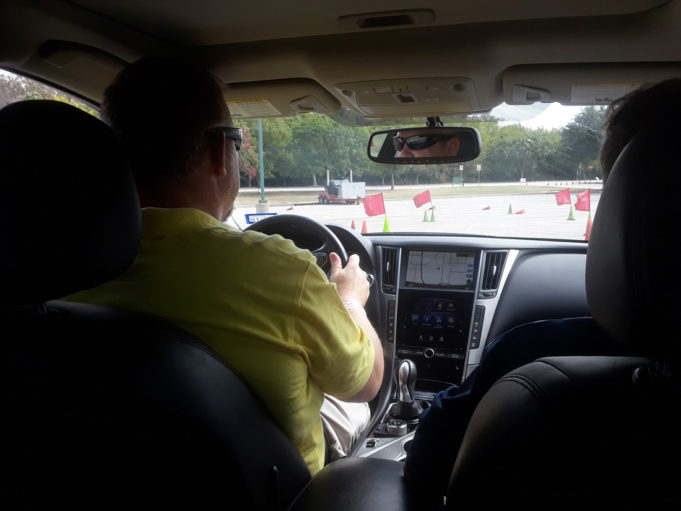As 16-year-old Kyle Vonbehren anxiously awaited his turn to drive through an obstacle course, driving coach Shawn Richard gave him the green light.
“Go ahead,” Richard said. “You’re good,” instructing the teenager from the front passenger seat. Vonbehren floored the gas pedal of his sporty Infiniti sedan, reaching speeds upwards of 40 miles per hour before slowing to hug several tight turns marked by bright orange cones. “I’ll take the first one slow,” Vonbehren said as he zoomed through a tight curve. One minute later, the course was completed. As the two chatted afterward, Vonbehren drove his car back to the start of the track, which was temporarily set up outside Southlake’s Dragon Stadium. Richard asked the student how he felt about the first run.
“Good,” Vonbehren said. “I would not have been able to do that before I took this class.”
The daylong course, called Street Survival, is run by local volunteers a few times a year. Instructors use advanced racing techniques to teach young drivers how to react in emergency situations. According to the Centers for Disease Control and Prevention, motor vehicle crashes are the leading cause of death for U.S. teens.
That afternoon, 31 teenagers and 18 coaches were participating in Street Survival. Event organizer Sam Graff said most of the coaches have professional or amateur auto racing backgrounds. “We’re trying to push [students] to the limits of handling,” Graff said. “When you race, you’re always on that limit. We are teaching emergency situations. If a tree falls down, [these students] will have the confidence and experience to handle it. We don’t want the first time someone experiences an emergency situation to be on the road.”
The program began at 9 a.m. The teenagers were split into two groups, one for classroom instruction and one for driving course lessons. On the track, students were taught several driving techniques. At one station, the drivers were required to brake so hard that their car’s anti-lock braking system engaged. Another station used a mixture of water and soap to create slippery road conditions that demonstrate what loss of traction feels like.
The occasional sounds of screeching tires were heard as Graff led classroom sessions in the afternoon. As he spoke, he occasionally pointed toward a large flat-panel television that displayed his talking points. One image was that of a text message a 22-year-old sent seconds before drifting into oncoming traffic. The young man died in the resulting car crash after his car slid off the road and rolled.
Back on the slalom course, Vonbehren began his second run. Over the past several hours, the student and other drivers had gained the confidence needed to push their cars to the limit, Richard said. Part of the instructor’s job, he continued, is to “gain the confidence of the students and to teach them to trust their training and their vehicle. At the beginning of the day, most kids rate their driving ability at nine or 10. After taking our class, they realize they’re at a three or four [out of 10]. If you can train someone what to do in a bad situation, once that situation happens, it’s second nature.”
He then turned to Vonbehren, asking the teenager to evaluate his driving skills. “I feel a lot more safe,” the young driver replied. “I feel I can control an emergency situation now that I’ve gone through this stuff.”












http://Www.streetsurvival.com
Just to be completely clear. We are not teaching kids to race. By putting them in the driver seat, thru exercises that demonstrate the limits of the car, and the capabilities of the vehicles dynamics, the kids get an understanding of maneuvers that will save their lives. It’s about removing the fear of the car once it’s out of control and showing them the proper technique to hopefully prevent it from getting to that point. As experienced drivers and racers what we have to teach is the knowledge of what a car feels like just before you have gone to far at typical daily driving speeds and in typical daily traffic situations. It’s about paying attention more than anything. But sometimes things are out of your control and then you have to get past the fear and know what to do to survive. Mostly it takes experience but a bit of knowledge certainly helps.